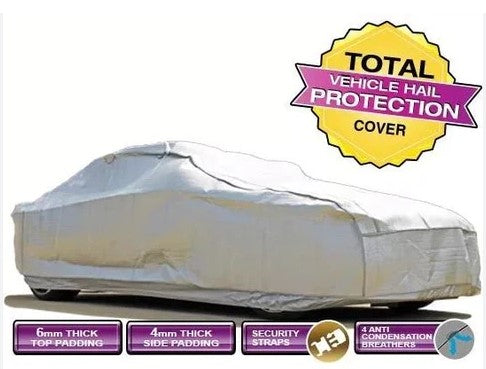
Which Materials Are Ideal for Car Covers?
Share
It’s important to choose the best material for your car cover, a poor choice can cause damage so which materials are ideal for car covers?
If you have an expensive car, then you will want to keep it protected from the elements. This is why you need to invest in a quality car cover that keeps your vehicle protected. It's important that you choose a material that's made specifically for the purpose. You may want a good dust-proof indoor cover or something to give you worry-free hail protection. You want something that will do the job and doesn't tear or get damaged after a few uses. There are many materials out there that are commonly used for making covers, but we'll go over some of the most popular ones below:
Oxford
Oxford is a durable material that can withstand the elements. It's also a high-quality fabric, so you can be sure that it will last for a few years. Oxford is usually lightweight and breathable, which means it won't add any unnecessary bulk to your vehicle (and make it harder for you to get in and out of). Finally, oxford is water-resistant, an important feature if you live somewhere where rain falls frequently.Note it is water-resistant and NOT waterproof. Oxford material also has some problems with UV rays and can deteriorate quite quickly in the Australian sun.
PVC
PVC is a type of plastic that is used in many things including car covers. This is a synthetic material that is not biodegradable. It's a common material used in car covers because it's inexpensive and easy to mould into different shapes, but there are some drawbacks to PVC:
- It can be flammable under certain conditions. If you have an old or damaged cover with holes in it, this could be dangerous for your vehicle's paint job and interior parts like leather seats or dashboards. Under PVC they may get too hot from direct sunlight.
- The fumes released by burning PVC are toxic when inhaled over long periods of time (about 15 minutes) and may cause headaches, nausea/vomiting etc., which might make it hard for someone inside their car while they're waiting at traffic lights during summer months (or any other time).
- It is difficult to haver a soft inner layer on PVC to prevent damage to paint work. However it makes an excellent, strong transparent car bubble cover for indoor use.
Polyester - Which Materials Are Ideal for Car Covers?
Polyester is a synthetic fibre that is commonly used in the production of car covers. It's durable and strong, which makes it ideal for outdoor car covers. Polyester also has many other benefits that make it a good choice for indoor and outdoor use:
- Lightweight--Polyester is lightweight compared to other materials, so it can help you save money on shipping costs and its lighter to install on your car.
- Breathable—Some Polyester allows heat and moisture to escape through its pores, keeping your vehicle cooler during hot summer days as well as helping prevent mould growth. Any material that can breath is generally water-resistant and not water proof, more information below.
- Water resistant--Water won't soak through polyester like it does with some other types of fabrics; however, if there's too much rain then water will drop off onto whatever surface sits below your car cover rather than soaking into the material itself.
P.E waterproof fabric
P.E waterproof fabric is made from polyethylene, a type of plastic that's used in many other products, including packaging and plastic bags. Because it's so durable and flexible, P.E waterproof fabric can be used in a variety of applications--including as a material for car covers.
How Is P.E Waterproof Fabric Made?
P.E waterproof fabric is made by blowing air into molten polyethylene to create bubbles; this process turns the liquid into strands of fibre that are then woven together or spun into yarns to

create cloth or sheeting with varying thicknesses (0-3 mm). The resulting product can be tailored to specific needs based on what kind of protection you need. Cars covered with these types of covers during summer months without any ventilation holes should NOT be used. It is a waterproof fabric. Most of the outdoor car covers supplied by Car Covers and Shelter use PE fabric but all covers have at least 4 ventilation points.
AT Carbon Texture
Carbon texture material is sometimes used for car covers because of its strength, durability and ease of maintenance. This type of fabric is often used for indoor use because it's not as breathable as other fabrics but still offers protection from dust, dirt and moisture. We do not recommend covers made of Carbon Texture for indoor or outdoor use. The weave is tight and ‘heavy’.
As it is does not get damaged with petrol or oil spills and it is tough, this is the material used for the floor base in Car Bubbles.
Polyester Cotton
Polyester cotton is the most common material used for indoor car covers. It is light and stretches well to show off the contours of the covered car. Polyester Cotton is very different to natural cotton which is sustainable, breathable and absorbent. Polyester is a man-made fibre that repels water and does not break down. It comes in many different ‘weights’ and it can allow your car to breath between the fabrics. Ideally, you should look for a car cover ‘weight’ between 180g/m2 and 220g/m2. Any lighter/thinner and dust will easily penetrate and any heavier makes it hard for the material to ‘breathe”.
Satin or Polyester Satin
Satin is a soft, luxurious fabric that's often used in dressmaking and the fashion industry. It has a smooth surface and can be made from natural or synthetic fibres. Satin is popular for use in indoor reveal car covers because it's lightweight and easy to move around. A reveal in a showroom can be achieved with one easy sweep of the hand. Because it is easy to move around, it is not recommended as a protective indoor car cover.
While satin may seem like an odd choice for outdoor car covers (the word "satin" brings to mind images of fancy dresses), it actually makes sense when you consider what makes up most satins: polyester or nylon fabrics with a high thread count (meaning many threads per square inch). These materials are strong enough to withstand weather conditions such as rain or snow and can withstand a couple of years of UV light exposure. It is a very expensive outdoor cover for what you get.
Velvet or Polyester Velvet
Velvet is a woven tufted material where threads are distributed in a short pile which gives it its distinctive “velvet” feel. It used to be made from silk, so it was always expensive. Today we have various types of artificial velvet made from various materials like wool, cotton and linen. Velvet is woven in two layers at the same time and is still quite an expensive fabric.

It does make the best indoor car covers, giving off that velvet ‘shimmer’ that only velvet seems to achieve. Car Covers and Shelter’s best-selling bespoke (made -to-measure) indoor cover is velvet material.
PU (Polyurethane)- Which Materials Are Ideal for Car Covers?
PU (polyurethane) is a synthetic fabric made of polyurethane. It's resistant to water and moisture and can breathe so it's ideal for outdoor use. This is the fabric often used to make artificial leather handbags. PU is also very durable: it can withstand harsh weather conditions like rain, snow and UV rays and can stretch.
This material is lightweight but strong enough to protect your car from dust or scratches. It is the preferred fabric for making custom-made bespoke outdoor covers.
Nylon
Nylon is a synthetic material that's commonly used in the making of cheap car covers. It's highly durable and waterproof, so it can protect your vehicle from rain, snow, and UV rays. It cannot breathe and many nylon covers do not have air vents. If you are thinking of buying a cheap nylon or plastic car cover, your car might be better off in the open! They can cause a quick build up of moisture which may damage paintwork and will eventually cause corrosion.
Nylon is easy to clean; you simply need to wipe it down with a damp cloth when necessary. This material doesn't absorb water like cotton does, which means there will be a build-up of mildew or mould growing on your cover if you leave it on for any extended period.
We have listed some of the most popular materials used in making a car cover today.
Car covers are made from a variety of materials. The most common types include:
- Vinyl - Vinyl is durable and flexible, but it's not waterproof or breathable. It can be quite heavy and difficult to install but is easily cleaned with soap and water. It's not as easy to maintain as other materials that require less frequent washing.
- Polyester - Polyester car covers are waterproof, windproof and breathable vents can be included; they're also easy to clean and maintain because they don't absorb stains like some other fabrics.
Summary - Which Materials Are Ideal for Car Covers?
In summary, we hope that this article has helped you to understand the different types of materials used to make a car cover. We also wish to stress that it is important for you to research your options before making a purchase decision so that you can be sure that it will suit all your needs and requirements.

3 comments
Twist and Disturb board—combining the best of both worlds! The screenless dash cam is a game-changer for those who value safety and simplicity on the road. Whether you’re an emergency responder or just want peace of mind, this device is a must-have. Acc4u really knows how to deliver top-notch products!
Informative article on car cover materials It highlights key factors like durability and protection, helping readers make an informed choice.
Good informative article check out these latest car accessories only at https://www.razrindia.com/